The last “big ticket†item of our year long adventure began with our visit to the Incan ruins around Cusco and would finish with a hike to Machu Picchu. I was super excited to learn more about the Incas and see some of their famous stonework in person.
We arrived in Cusco early on June 6 after an overnight bus from Arequipa without a hotel reservation. So the first order of business was to secure a room in the most touristy city in Peru during peak season. The first 3 Lonely Planet’s picks were full, and we were getting more frustrated by the minute for not making reservations. Outside the third place, a woman approached us with a business card for her hostal. Normally, we say no right away but in this situation we decided to check it out. The room ended up being perfect with tons of windows, wood ceiling beams, and a cheap price to boot! So, sometimes it is good that we don’t make reservations!
After cleaning up and eating, we headed to our tour agency to sign up for a tour of the Sacred Valley the next day and pay the remainder of our Machu Picchu trek. With our business out of the way, we had the rest of the day to explore Cusco and relax.
Cusco was the Inca capital before the Spanish conquest, but all that remains in town are a few stone walls. Most of the temples and buildings were disassembled and the stones used to build churches and houses for the Spanish. The main square is beautiful with colorful flowers and trees in the center and 2 churches towering over it. Tons of locals and tourists were milling about and enjoying the sunshine. We had read that Cusco has festivals often, so we thought maybe something was going on.
A few minutes later, we heard music, and around the corner came a parade. There were 20 boys carrying a huge, wooden statue of a saint and a small band playing. They proceeded to carry the saint into one of the churches. Not knowing the significance, we asked another bystander and found out that they were preparing for the Corpus Christi celebration for the next day. Little did we know that we were in town for a huge fiesta!
Corpus Christi in Peru is celebrated as a combination of Inca and Catholic traditions. The Incas used to parade around with mummies of the noble families to honor the dead once a year. So when the Spanish came, they modified the celebration to carry the town saints around the square. Following the parade is a big party where cuy (guinea pig) is eaten in celebration and to bring good health. Good timing on our part to be able to observe this major holiday!
On June 7th, we toured the Inca’s Sacred Valley with a group of 10 and our tour guide, Isaac. On our drive to the first site, Isaac told us the history of the Incan empire. I had forgotten that they didn’t have a long reign with only 100 years at the very peak of the empire. The Spanish killed all of the noble families and priests, so much of the knowledge perished, and only parts of their culture lived on through the lower classes. So, most of what we know now about the ruins is an educated guess.
Our first stop was a small craft fair, and our guide said that most of the crafts were made in the village so we would get a good price. So we went shopping, but everything turned out to be the same old stuff that we have been seeing since Bolivia!
The tour did get better, though, with our next stop at the Pisac ruins. This area of the valley was once a huge farming area with most of the produce getting shipped to Cusco to feed the capital. The ruins were high up on the mountainside with many terraces. On the lower terraces, corn would be grown, then quinoa and potatoes and finally, on the highest terraces, tubers. All was based on the optimal growing temperature for the crops. Smart Incas!
Isaac explained how the Incas learned to graft potatoes and corn to end up creating 500 different types of corn and 4,000 types of potatoes! The Incas also figured out how to freeze dry potatoes to last 1,000 years. I am not sure where the 1,000 years came from since the Incas didn‘t rule that long ago, but I would believe 600, which is still impressive! They used these potatoes in times of draught, earthquakes, and also to feed their soldiers.
The common houses in the complex were built with regular stones held together with mortar made of clay, llama hair, and water. Temples and noble houses were made with stones perfectly carved to fit without the need for mortar. All of the rocks were a perfect fit, and it was really amazing to look at all the different angles. The Inca’s must have been patient people! The exteriors of the temples were plated in gold. It was hard to imagine what it would have looked like back in the day!
Our next stop was Ollantaytambo which was the only battle in which the Incas defeated the Spanish, claiming victory by flooding the valley floor beneath the city to slow the horses down. Ollantaytambo is also famous as the best example of an Incan city design. The city is shaped like a llama, which is a sacred animal in their culture. The ruins also have great terraces leading up to the temples at the top of the city.
The unfinished sun temple was amazing. On one side were the completed “choir†stalls, which were niches built into the walls to hold important ceremony objects. Each niche was the exact same size and at the exact same level. The one completed wall of the temple was huge. Each stone was 10’ tall and 4’ wide. I kept trying to imagine how they moved these huge stones from 4km away and across a river! The center stone had the start of the Inca cross carved into it. Each line of the cross symbolizes one of the Incan commandments to live by.
Across from the ruins on another mountainside were the warehouses and a huge pre-Inca carving of a god with a crown on his head carrying a bag.
At the base of the ruins was the water temple using a water system which was built to bring fresh water from the base of the snowcap to the city. The Incas built stone pipes to carry the water, so it was untouched for 8km from the snow melt to the city. The water still runs through the sacred fountains today.
The last stop of the tour was the tiny village of Chincheros to look at the colonial church. When we arrived, the town was busy with all the villagers partying for Corpus Christi. Outside the church in town square, it was a major rave! Ten different bands were playing, with some people dressed up as Incas and others with Spanish costumes and dancing traditional dances. Also, there was food everywhere and tubs of corn beer with people just dipping their empty cups into the tub. It was one of the happiest parties I have ever seen, and it was really neat to see both cultures celebrating together.
Back in Cusco, the parties were going at full steam, but we had to skip out early to prepare for our 5 day trek to Machu Picchu. Our day in the Sacred Valley was beautiful, and we learned so much. The Incas were talented and patient people, and we were now really excited to see the “Lost City.â€

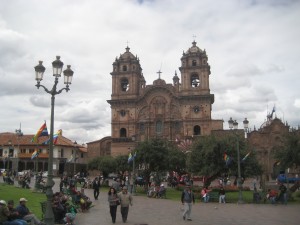
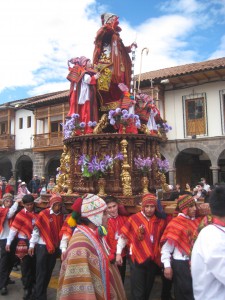
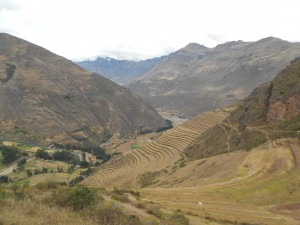
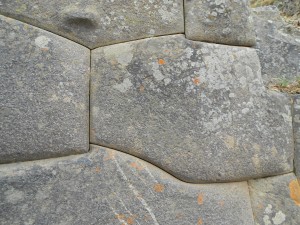
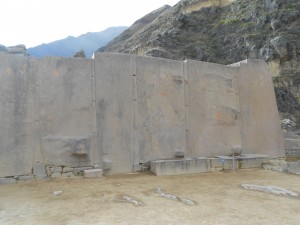
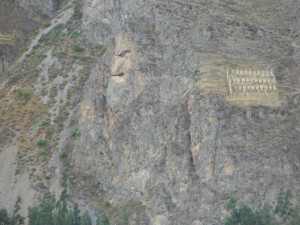
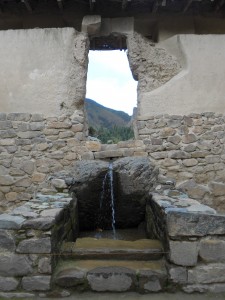
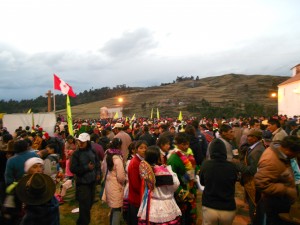
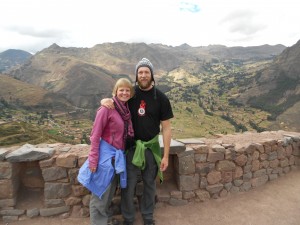
This is my favorite of your visits! I just read *Turn Right at Machu Picchu* by Mark Adams. I have been fascinated by the Incas since I researched them for a seventh grade English class. Yay on you two for getting there.
Thanks, Joan. Our trip to Machu Picchu was amazing; we will get details up on the blog soon. Hope summer is off to a good start for you.